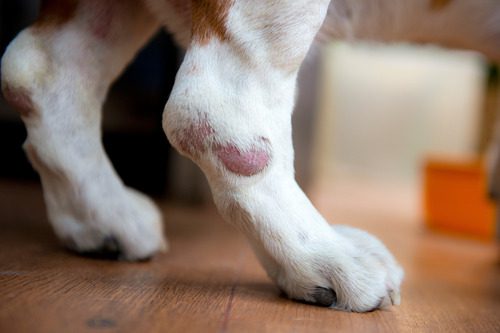Dog Hot Spot Healing Stages
Hot spots can be an uncomfortable and alarming issue for any dog owner to witness. If your dog suddenly develops a red, oozing patch on their skin, it’s natural to feel concerned. Understanding the dog hot spot healing stages can make a big difference in recognizing what’s normal during recovery and when professional care is needed. By learning what to expect, you’ll feel more confident helping your dog through the healing process. Below, we’ll walk you through the typical stages of hot spot healing and when it’s important to reach out to Groveport Canal Animal Hospital for help.

What Is a Hot Spot on a Dog?
Before diving into the dog hot spot healing stages, it’s important to understand what a hot spot actually is. A hot spot, also known as acute moist dermatitis, is a localized area of skin inflammation and infection. These spots often appear suddenly and can worsen quickly if not addressed. Hot spots typically feel warm to the touch and may ooze pus or fluid. They are often caused by a dog’s instinctive scratching, licking, or chewing in response to irritation. Common triggers include allergies, insect bites, moisture trapped against the skin, or underlying skin infections. Hot spots require attention because the more a dog licks or scratches the area, the larger and more painful it can become. Proper treatment supports healing and helps prevent further complications.
The Stages of Healing for Dog Hot Spots
Healing progresses through several clear phases. Each stage signals important changes in the skin’s repair process.
Stage 1: Initial Inflammation and Development
The first stage of a hot spot involves rapid inflammation. During this phase, you might notice:
- Redness and swelling
- Moist or oozing skin
- Hair loss around the affected area
- Your dog excessively licking or chewing the spot
This stage can develop within hours. The skin appears raw, irritated, and sometimes emits an odor if infection has set in. Veterinary care at this point is highly recommended to control the irritation and stop the spread of infection.
Stage 2: Stabilization
Once treatment begins, the hot spot enters the stabilization stage. During this phase:
- Oozing lessens
- Redness may still be present but should not worsen
- Scabbing may begin to form as fluid production decreases
- Your dog may still show interest in the area but with less intensity
At this point, the body’s healing response starts gaining control over the infection. Veterinary-prescribed treatments, such as topical therapies or medications, greatly support this phase. Dogs often require e-collars to prevent further self-trauma.
Stage 3: Early Healing
The early healing stage typically follows a few days after stabilization. Signs include:
- Scabs hardening over the wound
- Less redness and swelling
- New skin beginning to form underneath the scab
This stage is encouraging because it shows the skin is starting to repair itself. It’s important to monitor the scab closely. Picking or scratching at scabs can cause setbacks and may lead to reinfection.
Stage 4: Tissue Regeneration
As healing progresses, the hot spot moves into tissue regeneration. During this dog hot spot healing stage, you’ll observe:
- Flaky or peeling skin as the old tissue sheds
- Healthy, pink skin emerging underneath
- Decreased sensitivity or discomfort for your dog
While the area may still look rough, this new skin is a positive sign of recovery. Hair may start regrowing slowly, although the final appearance can vary depending on the hot spot’s severity.
Stage 5: Full Recovery
In the final stage of dog hot spot healing, the skin returns to a more normal appearance. This phase features:
- Complete regrowth of fur (which can take several weeks)
- No remaining scabbing or discharge
- Full return of skin integrity
Some dogs may experience minor discoloration in the healed area for a time, but this typically improves. Continued skin care and allergy management help prevent future hot spots from developing.
Factors That Influence the Dog Hot Spot Healing Stages
Several factors can affect how quickly and smoothly your dog moves through the dog hot spot healing stages.
Severity of the Hot Spot
Smaller, mild hot spots generally heal faster than larger or deeply infected ones. Severe cases may require a longer treatment period, including antibiotics and more intensive wound care.
Timeliness of Veterinary Care
Prompt veterinary attention can significantly shorten the healing timeline. Early intervention stops the cycle of infection and self-trauma before it becomes more serious.
Your Dog’s Overall Health
A dog’s immune system plays a major role in healing. Dogs with allergies, endocrine disorders, or chronic skin conditions may take longer to heal and need ongoing management.
Home Care and Compliance
Following all veterinary instructions, including administering medications and preventing licking or chewing, helps your dog move through each healing stage efficiently.
How Long Does It Take for a Dog Hot Spot to Heal?
Most hot spots start showing improvement within 3-5 days of treatment. Full healing can take anywhere from 7 to 14 days, depending on the severity. In more complicated cases, complete fur regrowth might take several weeks. If a hot spot worsens, spreads, or does not show signs of improvement within a few days, it’s important to schedule a follow-up with Groveport Canal Animal Hospital. Our team can evaluate the healing process and make adjustments to your dog’s care plan if needed.
When Is It Necessary to Seek Veterinary Help for a Dog’s Hot Spot?
Even when you understand the dog hot spot healing stages, it’s important to recognize when your dog needs professional care. You should contact Groveport Canal Animal Hospital if you notice:
- Rapid expansion of the affected area
- Persistent or worsening discharge
- Intense pain or extreme sensitivity
- Fever or changes in behavior
- No improvement after a few days of home care
Seeking timely veterinary attention supports faster healing and protects your dog from further discomfort. Call us today at (614) 836-3222 or book an appointment online if your dog shows signs of a hot spot.
Helping Your Dog Feel Comfortable Throughout the Healing Process
Helping your dog stay comfortable throughout the healing process encourages better outcomes. Some ways to support your dog include:
- Using an e-collar to prevent licking
- Keeping the wound area dry and clean
- Administering all prescribed treatments on schedule
- Offering plenty of affection and positive reinforcement
- Keeping your dog’s environment calm and stress-free
Every dog deserves a smooth, stress-free recovery. If you have any concerns about your dog’s hot spot or its healing progress, our team at Groveport Canal Animal Hospital is here to help. Call us at (614) 836-3222 or book an appointment online to get your dog back to feeling their best.

